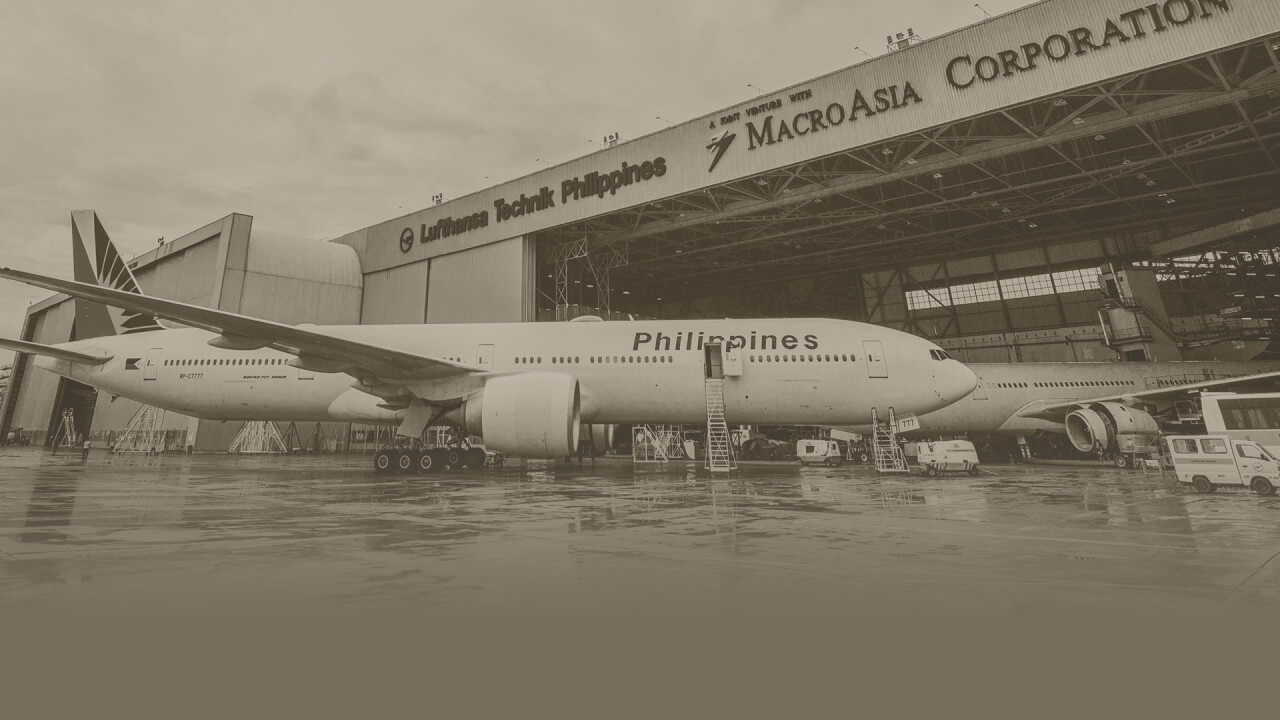

We are infamous for it, which is why companies and individuals entering into deals with the state usually price in generous profit margins to account for the possibility of sudden and unexpected contract alterations by politicians.
But the situation with Lufthansa Technik Philippines (LTP) — one of the largest locators in the Ninoy Aquino International Airport (NAIA) complex — is NOT an example of this.
This time around, neither the government nor the new NAIA operator, San Miguel Corp., is altering the deal midstream by jacking up lease rates. Nope. LTP’s existing contract is simply expiring. And, if they wish to continue operating where their facilities currently stand, they will have to pay more. Ok, granted: a lot more.
A deal made a quarter of a century ago
LTP is a joint venture between Germany’s Lufthansa Technik AG with 51 percent and Macroasia Corp. of billionaire Lucio Tan with 49 percent.
They struck a deal in 1999 to put up LTP using the existing technical center of Philippine Airlines made up of maintenance hangars that stood on the same location. The Germans invested billions of pesos to build additional hangars and bring in advanced aircraft maintenance equipment, to complement PAL’s facilities.
As the 25-year lease agreement of LTP for its aircraft maintenance, repair, and overhaul (MRO) facility at NAIA nears expiration on Aug. 31, 2025, the question of an appropriate lease rate adjustment has become a crucial discussion.
And what does a lessor do with an expiring deal that was sealed a quarter of a century ago, when property prices were still depressed in the wake of the 1997 East Asian financial crisis? Why, he raises the rate, of course, to put it on par with prevailing property prices.
Tenfold price increase
As such, the proposal to increase LTP’s current lease rate from P65 per square meter per month to P710 per square meter — as mandated not by San Miguel, but by the government’s privatization terms — is not just justified but necessary.
LTP has long benefited from a cheap lease rate of P14.6 million a month for the 226,000 square meters it occupies. This is well below market value when compared to similar industrial and commercial properties within Metro Manila.
The proposed increase to P710 per square meter (a monthly lease of P160.4 million) aligns the rate more closely with prevailing market prices, and ensures that the government receives fair compensation for the use of a prime property within the country’s main international gateway.
The government? Yes, the government gets most of that money — not San Miguel — 82 percent of total revenues, in fact, under the terms of the bid which the conglomerate won.
NAIA is a valuable public asset and, by bringing the lease rate up to competitive levels, the government can ensure that state-owned properties are not being leased out at outdated and disadvantageous rates.
Growth, profitability of LTP
LTP is a highly profitable and well-established MRO provider, benefiting from NAIA’s strategic location and access to the fast-growing aviation market in the Asia-Pacific. Over the years, the company has seen significant business growth, servicing major airlines and continuously expanding its operations.
A lease rate adjustment is a reasonable expectation for a multinational corporation that derives substantial revenue from its operations within a public facility.
What now, LTP?
LTP made a smart business move by locking in a cheap lease rate for 25 years back in 1999. But that lease is ending, and it now faces a very different market.
Will the Germans leave NAIA once their contract ends in a few months? That cannot be ruled out at this point.
One option is for LTP to relocate their operations to Clark International Airport where land is plentiful, and lease rates are still relatively affordable. In fact, the firm is already building maintenance facilities there as announced last year.
A full relocation will take about three years, we’re told. And the company will be faced with the challenge of relocating 3,300 of highly skilled Manila-based technicians and support employees to Pampanga, a task easier said than done.
If LTP leaves, San Miguel can use 22 additional hectares for airport improvements, or it can lease out the same space to rival MRO firms like Hong Kong’s HAECO or Singapore’s SIA Engineering at better rates.
Can LTP afford the lease rate increase? Based on the annual report of its profitable parent firm, it can. But it will hurt. Shareholders will end up keeping less of the firm’s revenues (total sales of LTP for 2024 was 273 million euros or about P17 billion).
Difficult choices ahead
The government faces a tough choice. Should it make concessions to LTP by mandating San Miguel to charge lower lease rates?
The conglomerate probably won’t mind this if corresponding adjustments are made to either the amount that it will remit to the state, or if its scope of work for NAIA is reduced (given the reduction in resources it will have to implement its planned improvements).
How about cash rebates to LTP, similar to a proposal made last year by parties affected by airport fee hikes, which the Department of Transportation declined to act on?
It’s possible. But which transportation secretary in his right mind would risk being hauled before the Ombudsman at some future date once political winds have shifted (as they always do here) “for causing undue injury to the government or giving unwarranted benefits to a private party”?
How about incentives for LTP from the national government in the form of additional tax breaks?
The President can order that with a stroke of his pen, but doing so at a time when the government needs every single peso it can collect might be politically problematic.
Or should the government simply engage the Germans in a staring match to see who blinks first (potentially putting the jobs of 3,000 Filipinos at risk)?
To be sure, the visibility for LTP’s future remains limited.
But what’s clear is that a substantial increase in the lease rate is a necessary correction that reflects the true value of airport land while ensuring fair compensation to the government.
Just by how much that rate will increase — and, most importantly, who will bear its brunt — will depend on how much political the Marcos administration and Transportation Secretary Vince Dizon have.

Senior Reporter